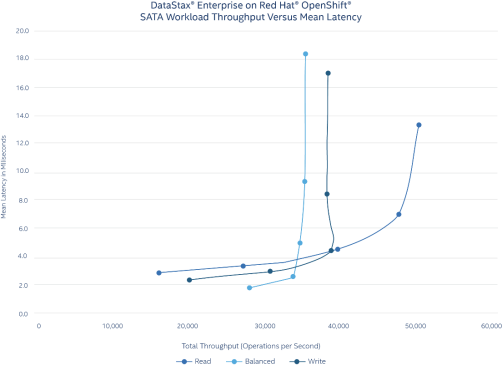Red Hat OpenShift and VMware Tanzu configuration with SATA SSDs
Home > Workload Solutions > Data Analytics > White Papers > Application Modernization for High-Volume Workloads with DataStax > Red Hat OpenShift and VMware Tanzu configuration with SATA SSDs
Red Hat OpenShift and VMware Tanzu configuration with SATA SSDs
-
Figure 3 displays the combined results of the DataStax Enterprise benchmark tests for the read-intensive, write-intensive, and balanced read/write scenarios on the Red Hat OpenShift cluster, while Figure 4 displays the same results for the VMware Tanzu cluster running on SATA SSDs. The x-axis displays the total throughput in operations per second performed during each test’s 10-minute run, while the y-axis displays the mean latency in milliseconds for each operation during the run.

Figure 3. SATA SSD benchmark results for the DataStax Enterprise read-intensive, balanced read/write, and write-intensive scenarios on the Red Hat OpenShift cluster
The Red Hat OpenShift cluster test consisted of five test runs for each read-intensive, write-intensive, and balanced read/write scenario. Each data point on the chart represents a test run with a specific number of client threads that simulate client loads. The number of client threads for each test run were:
- First test run: 40 client threads
- Second test run: 80 client threads
- Third test run: 160 client threads
- Fourth test run: 320 client threads
- Fifth test run: 640 client threads
Figure 3 shows that latency moderately increased for the 90 percent read/10 percent write scenario, while the latency dramatically increased during the mixed 50 percent read/50 percent write (balanced read/write) and 10 percent read/90 percent write scenarios as the number of client threads increased. The maximum operations per second occurred with the 90 percent read/10 percent write workload at 49,433 with 640 client threads.

Figure 4. SATA SSD benchmark results for the DataStax Enterprise read-intensive, balanced read/write, and write-intensive scenarios on the VMware Tanzu cluster
The VMware Tanzu cluster test consisted of five test runs for each read-intensive, write-intensive, and balanced read/write scenarios. As with the Red Hat OpenShift tests, each data point on the chart represents a test run with a specific number of client threads that simulate client loads. The number of client threads for each test run were:
- First test run: 18 client threads
- Second test run: 72 client threads
- Third test run: 144 client threads
- Fourth test run: 288 client threads
- Fifth test run: 576 client threads
Figure 4 shows latency moderately increased during the mixed 50 percent read/50 percent write (balanced read/write) and 10 percent read/90 write scenarios, while the latency increase was slightly higher during the 90 percent read/10 percent write scenario. The maximum operations per second occurred with the 10 percent read/90 percent write workload at 115,817 with 576 client threads.
